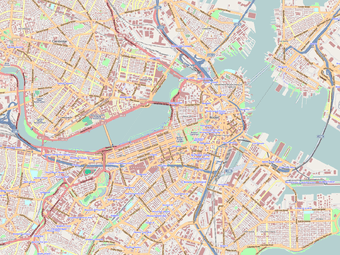Charles Street Jail
|
Suffolk County Jail | |
 | |
   | |
| Location | Boston, Massachusetts |
|---|---|
| Coordinates | 42°21′43″N 71°4′13″W / 42.36194°N 71.07028°WCoordinates: 42°21′43″N 71°4′13″W / 42.36194°N 71.07028°W |
| Built | 1851 |
| Architect | Bryant,Gridley J.F. |
| Architectural style | Other |
| NRHP Reference # | [1] |
| Added to NRHP | April 23, 1980 |
The Charles Street Jail (built 1851) or "Suffolk County Jail" is an infamous former jail (later renovated into a luxury hotel) located at 215 Charles Street, Boston, Massachusetts. It is listed in the state and national Registers of Historic Places. The Liberty Hotel, as it is now known, has retained much of the historic structure, including the famed rotunda.
History

_-_aerial_view.jpg)
The jail was proposed by Mayor Martin Brimmer in his 1843 inaugural address as a replacement for the Leverett Street Jail which had been built in 1822. Normally jails of this sort were county institutions, but, since Boston, then and now, dominates Suffolk County, Mayor Brimmer was a key player in the jail's planning and development.
The jail was constructed between 1848 and 1851 to plans by architect Gridley James Fox Bryant and the advice of prison reformer, Rev. Louis Dwight, who designed it according to the 1790s humanitarian scheme pioneered in England known as the Auburn Plan. The original jail was built in the form of a cross with four wings of Quincy granite extending from a central, octagonal rotunda with a 90-foot-tall (27 m) atrium. The wings allowed segregation of prisoners by sex and category of offense, and thirty arched windows, each 33 feet high, provided ventilation and natural light. The original jail contained 220 granite cells, each 8 by 10 feet (2.4 m × 3.0 m).
Over the years, the jail has housed a number of famous inmates including James Michael Curley, Malcolm X, Sacco and Vanzetti, suffragists imprisoned for protests when President Woodrow Wilson visited Boston in 1919, and World War II prisoners of war from the German submarines U-234 and U-873. The commanding officer of the latter U-boat, who died in the jail, was the brother of Operation Paperclip rocket scientist Ernst Steinhoff.[2]
In 1973, the US District Court ruled that, because of overcrowding, the jail violated the constitutional rights of the prisoners housed there. Nonetheless, the prison did not officially close until 1990. On Memorial Day of that year, prisoners were moved to the new Nashua Street Jail on Nashua Street.
The building is now owned by the Massachusetts General Hospital. It has since been redesigned by Cambridge Seven Associates[3] and Ann Beha Architects, and reopened in the summer of 2007 as a 300-room luxury hotel with a number of high end bars and restaurants, operated by MTM Luxury Lodging. The Liberty Hotel, as it is now known, has retained much of the historic structure, including the famed rotunda.
See also
References
- ↑ National Park Service (2007-01-23). "National Register Information System". National Register of Historic Places. National Park Service.
- ↑ "Friedrich Steinhoff". Guðmundur Helgason. Retrieved 2012-10-05.
- ↑ C7A.com Archived July 8, 2011, at the Wayback Machine.
- George M Cushing, Great Buildings of Boston a Photographic Guide, Courier Dover Publications, 1982, page 42. ISBN 0-486-24219-6.
- Massachusetts General Hospital history
Further reading
- Inmates of Charles Street Jail v. Eisenstadt, 360 F.Supp. 677 (D.Mass. 1973).
- 577 F.2d 761. INMATES OF SUFFOLK COUNTY JAIL et al., Plaintiffs, Appellees, v. Dennis J. KEARNEY et al., Defendants, Appellees, Boston City Councillors, Defendants, Appellants. No. 78-1216. United States Court of Appeals, First Circuit. Argued June 9, 1978. Decided June 15, 1978.
External links
| Wikimedia Commons has media related to Charles Street Jail. |

